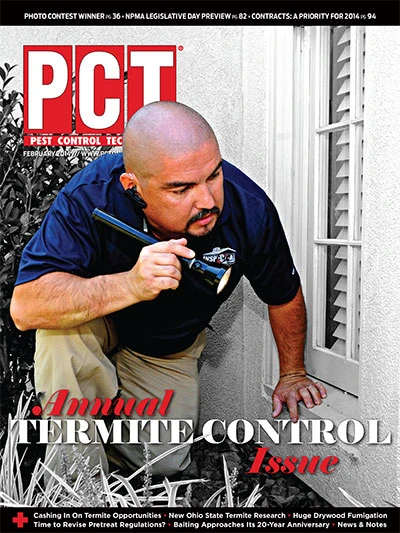 So, as the days got shorter and the weather turned cooler, some of the overwintering pests such as boxelder bugs, brown marmorated stink bugs, cluster flies, multi-colored Asian lady beetles (ladybugs) and kudzu bugs (presently found as far north as northern Virginia) invaded your customer’s building as a cozy place to spend the winter. And, your customer’s solution has been to have someone suck them up with a vacuum cleaner ever since.
So, as the days got shorter and the weather turned cooler, some of the overwintering pests such as boxelder bugs, brown marmorated stink bugs, cluster flies, multi-colored Asian lady beetles (ladybugs) and kudzu bugs (presently found as far north as northern Virginia) invaded your customer’s building as a cozy place to spend the winter. And, your customer’s solution has been to have someone suck them up with a vacuum cleaner ever since.
Now, on warmer days they’ve become a major aggravation, especially on the sunny side of the building (rooms on the south and adjoining portions of the east and west walls). The complaints are ever increasing in frequency. Although these pests have been active all winter long on sunny days that warm up the sunny side of the building, their presence is becoming more common and frequent as spring approaches. So, what can you do?
Reinvasion Prevention.
Concentrate your efforts on the affected rooms located on the warm side of the structure, typically the south wall and the southern portions of the adjoining east and west walls.
- Suggest to clients that they first remove the pests with a shop vacuum (not for stink bugs) and immediately empty the vacuum into a plastic bag, seal the bag and dispose of it in an outside trash can. If there are literally hundreds of pests in a room or they are stink bugs, they should call a pest management professional and have the room treated. After the pests are dead, vacuum them up without stepping on or crushing any because that could cause stains on carpeting. After the pests have been removed, the only procedure that should be done to prevent their re-entry into the inside of the structure is to seal their possible routes of entry.
- Use caulk and/or foam to seal cracks and crevices. For the smaller cracks and crevices, use caulk, but be sure to use the kind that is flexible and that can be painted, or use clear, flexible caulk if you are sealing naturally finished wood or other surfaces that will not be painted. Expandable foam can be used to seal the larger cracks and crevices that are hidden from view, such as those around electrical boxes hidden by cover plates.
Areas to be sealed include:
- Window and door frames. Seal around the outside of the frame where the frame meets the wall.
- If your customers have double-hung windows that have window pulleys, seal the pulley holes with tape or stuff them with fabric (tie the end piece of fabric around the cord so that you can easily retrieve and remove the fabric in the spring).
- For electrical outlets and switch boxes, first be sure that the electricity is turned off, and then remove the cover plate, close the gap between the box and the wall, and replace the cover.
- For heating duct and air-return vents, remove the grate, close the gap between the duct and the wall/floor, and replace the cover.
- For light fixtures and ceiling fans, first be sure that the electricity is turned off, and then remove the fixture to the electrical box behind its base plate, seal the gap between the box and the wall, and then replace the fixture.
- For canister lights, remove the decorative trim/plate and seal the fixture-to-ceiling junction, but do not seal the air vents on canister lights (they are required to allow heat from the bulb to safely escape).
- For skylights, seal the junction of the skylight box or its trim with the ceiling.
- For baseboards, seal the junction of the baseboard to the wall and floor.
Entryway Door Prevention.
Pests coming in through the doors? Here are some tips.
- Door-to-doorframe gaps. Be sure no air is coming in around the door (use weather stripping to close any gaps). You can either use your hand to go over the door-to-frame junction to feel for colder air coming in and/or at night, with the inside lights on and the outside lights off, go outside and look for any light escaping to the outside indicating a gap to close.
- Thresholds. Close any gaps at the junction of the bottom of the door to the frame or step. Use a tight-fitting (no gaps) threshold plate and/or flexible seal for a tight fit; door sweeps can be used but don’t seal as tightly. Again, at night, no light should escape to the outside.
What Not To Do.
Tell your customers that no attempt should be made to kill these insects in wall voids at any time! Why? The bodies of dead insects attract dermestid beetles (carpet beetles, larder beetles, etc.) because they are a favorite food of their larvae (immature stages). Dermestid larvae wander and will readily enter the work space, causing frustration and concerns.
Dermestids are very difficult and sometimes impossible to eliminate in the exterior perimeter walls because the insulation present usually prevents pesticide from reaching them.
Suggest to the client that they be patient and wait until it gets warm in the spring, then they will leave your building on their own. And no, overwintering pests do not reproduce while overwintering, they wait until they leave the building for such activities.
What About Next Year?
Here are some tips to help sell your pest prevention services later this year. In June, seal the sunny side(s) of the building. Tips include:
- Several of these pests orient towards contrasting colors on these walls (light-colored walls with dark trim or shadows), so concentrate efforts here.
- They also like joints where structural elements meet, such as siding to foundation wall, siding elements, fascia-board junctions with masonry grooves, etc.
- Note any unsealed utility pipe wall penetrations, unscreened ventilation openings, weep holes, etc.
Added Bonus.
Think long-term. Doing the sealing as outlined previously will reduce the entrance of colder air into your customer’s building in the winter and the loss of cooler air to the outside during the warmer months of the year. This will increase the energy efficiency of their building and save energy costs.
Eric Smith is director of technical services/staff entomologist, Dodson Bros., Lynchburg, Va. He earned his undergraduate degree from Miami (Ohio) University in botany and his master’s (Purdue) and doctorate (Ohio State) degrees in entomology. He has 30+ years experience in pest management, is past president and member of Pi Chi Omega, chair of the Copesan Technical Committee, a BCE and senior author of the NPMA Field Guide to Structural Pests.
Copesan is an alliance of pest management companies with locations throughout North America. To learn more, visit www.copesan.com.

Explore the February 2014 Issue
Check out more from this issue and find your next story to read.
Latest from Pest Control Technology
- Moneypenny is a Provider of Virtual Receptionists
- Video: Top 10 PCT Photo Contest Finalists
- Massey Services Expands with Southeast Commercial Region
- Pest Management Foundation Announces Kevin J. Burns Scholarship
- How to Identify Clover Mites
- Termite Threat Halted in Southern Florida
- PCT Media Group Adds Managing Editor Katie Hobbins
- Evens Clerjuste on Team Communication as Company Growth Point





